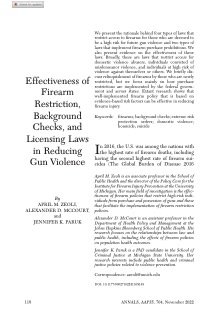By Kateira Aryaeinejad and Thomas Leo Scherer
Over the years, the National Institute of Justice’s (NIJ) funding for research has provided important opportunities to advance our understanding of topics related to crime and justice within the United States. Drawing from this portfolio, this synthesis paper compares and contrasts the data and findings from NIJ-sponsored research projects on violent extremism, mass shootings, and bias crimes. This comparison focuses both on the content of the data and on the creation and coverage of the data, examining findings from four research projects: ■ The Profiles of Individual Radicalization in the United States (PIRUS) database of 2,226 individuals who demonstrated at least 1 of 5 extremist or radicalized behaviors. ■ The Bias Incidents and Actors Study (BIAS) database of 966 adults arrested or indicted for bias crimes. ■ The National Hate Crime Investigation Study (NHCIS) database of 1,230 hate crime cases. ■ The Violence Project dataset of 172 mass shootings. This synthesis first reviews the creation of each dataset and the types of information that are collected to better understand their generalizability and the ability to make comparisons across separate datasets. There are significant differences in the size, time span, and information of the four datasets, which limits the comparisons that can be made between the individuals described in each dataset and necessitates caution in drawing strong conclusions from such comparisons. With that caution in mind, the datasets suggest some similarities in the individuals who commit bias crimes and mass shootings and display violent extremist behavior. These individuals are primarily males in their 20s and 30s and unmarried at the time of their offenses. They may exhibit higher rates of unemployment than the general population and often have prior criminal histories. However, that is not to say that these characteristics should be used as a profile to determine who is at risk of or more likely to commit any of these types of offenses or behaviors. Rather, it calls into question what other factors may be impacting individuals with these characteristics who go on to commit these types of offenses. The datasets also suggest some differences in the individuals who commit each type of offense or behavior. Individuals associated with violent extremism tend to be more educated than those who commit mass shootings or bias crimes. Individuals who commit mass shootings exhibit higher rates of mental health issues than those who commit bias crimes or participate in violent extremism offenses. The comparison of individuals across categories also highlighted differences among individuals who committed the same type of offense. Among individuals who supported violent extremism, for example, those acting in support of far-right ideologies were more likely to have military experience than those following other ideologies. Comparing these datasets highlights their potential and their limitations, suggesting paths forward for future research. The different collection methods show the importance of precisely describing the data collection method, discussing which behaviors are missed by that method, and triangulating among data with different methods to understand what is missing. The differences in the types of information that each dataset collects about each individual and action suggest that future collections could have greater overlap and comparability. The establishment of potential similarities in demographics and life experiences also allows for more targeted data collection focusing on why most individuals who fit that profile do not commit an offense, while others do. In this way, these projects not only contribute to our current understanding of these types of offenses and behaviors but also allow future research and programming to be conducted more effectively.
Washington, DC : U.S. Department of Justice, Office of Justice Programs, National Institute of Justice, 2024. 43p.





















